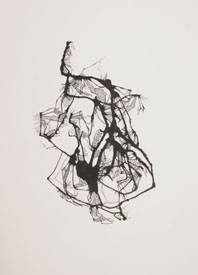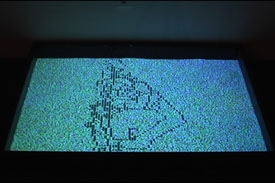Feature: Reviews
Tall Tales
- Micaela Gallery
- San Francisco, CA
- September 6-30, 2007
Micaela Gallery
333 Hayes Street
San Francisco, CA 94102
September 6-30, 2007
Tall Tales seems an unlikely name for this collaboration between Bay Area artists Peter Foucault and Scott Kiernan. The delicate spiders of Foucault’s blown ink maps and the kaleidoscopic images of Kiernan’s sand- and sound-scapes suggest psychic geographies rather than folk narratives.
But what would it mean to take this enterprise at its word—as hyperbole. Do the two artists form a liar’s circle, progressing from understatement to the most improbable and impossible of statements? Can “blowing up” fictions be another name for improvisation and invention? Can a dominant notion of infinity—the unfettered accumulation of pure information—be tested?
Foucault: Ink on Paper
Peter Foucault makes drawings and videos by employing chance, robotics and kinetic systems. To make the works on view here, he blew a small pool of ink on paper into a lace of tributaries. Unpredictable as the runs of ink are, they do not escape to the paper’s edge. The artist moves round the flat white paper to corral the vagrant ink at center stage. The awkward knotted strands of ink are then embroidered with tiny and deliberate marks drawn from a lexicon or key invented by the artist.
These black doilies (rather like a fairy scaffolding built of dead twigs and beetle legs) are suspended ambiguously between chance and design; abstraction and map. Thrust behind glass, ponderously framed, and dramatically lit, these fancies are elevated to faux grandiosity, threatening to fossilize as art objects. Individually they would die. As installation, the cumulative effect brings to mind memento mori. The sweetness of literally “inspired” landscapes resembles a dead butterfly collection. This viewer appreciates the artist’s choice of visceral disturbance over irony’s immunity. All maps are miniatures and elegantly framed maps on the wall are quotations from a golden age of cartography. Potentially, they recognize that the other and other world’s exist. At the same time, they are trophies that serve as idealized portraits of the self. (The Nicholas Roeg 1989 film “Track 29” is another example of exaggerating the dark play inherent in the miniature.) The scale of this ratcheting up will depend on Foucault’s deployment in future installations. A series of miniatures amplified into a grammar becomes a Rorschach test, threatening to make mountains out of tame molehills.
Extra Special Ops
Kiernan, the founder and driving force of ZENITH FOUNDATION*, tells his own tall tales. An early virtual intelligence program called “Game of Life” (written in the late 1970s by John Conway) is projected from the ceiling onto a sandbox below. Mounds and valleys of white sand or silica fill the box on the floor. The screen as static yet rolling landscape disturbs depth perception just enough to encourage a sense of anxiety. Black spots appearing and disappearing on a white background represent the population of an imaginary colony whose survival runs a precipice between death by isolation and death by overcrowding. Kiernan hypes this projection of the colony’s genealogical contingencies with an added layer of “white noise.” This break-up of the images is further magnified by the actual graininess of the silica piles. Like snow on acid, hallucinations of color sparkle through a destiny once set in black and white. Disturbance = Life. The screen’s disruptive reflectivity becomes the entire point. Or rather a banal non-point or understatement becomes an overstatement.
The New Moire
Kiernan uses yet another antique computer program to harvest feedback from images and sound to then sequence the same images and sound. While the sound fills the entire gallery, the video occupies a small room in the back of the gallery. His video/soundscape stars the artist as a cross between an experimental subject reminiscent of Gulliver’s Travels and Alice’s Madhattter-on-the-run. A tuning fork and a burning fuse steal the scenery; echos and incineration, the loop of longing and the animus of arson. A moiré overlaps two patterns to create an optical illusion. Like any decent tall tale, the move is away from the everyday lived experience of common sense. The artist’s body shows up as a measure of the ground no matter how telescoped or labyrinthine. If the precious worlds of tiny exist then so does the unruly worlds of giant.
Giving the Lie to the Information Age
Tall Tales is a fresh show of work that in future incarnations might get even more raw. Hyperbole is being investigated in complex ways both within the individual works or series and between the two artists. A liar’s club feeds on mutation and scorns the purity of transmission that parades as communication. The totalizing ideal of an “Information Age” claims to accumulate “pure” information and excise disinformation. The lie is that its bread and butter comes from capitalizing on disinformation at every fork and at the end of every fuse and exhale.
Traditionally, tall tales are stories by marginalized travelers: rail road crews and porters, lumberjacks and harvest workers, camp followers and sharecroppers, hobos and sailors, immigrants and evicted. Such folk may have come to know the landscape better than others yet their stake or claim to any single location is precarious. Tall tales can remind us that we are all seasonal and itinerant workers whose best tactic for witnessing the Big lie is often a bigger lie.
*Kiernan describes ZENITH FOUNDATION as “a loosely organized collective of none exploring the suggestive powers of sound and geometry.”
**For more about the miniature and the gigantic, see Susan Stewart’s book On Longing.



